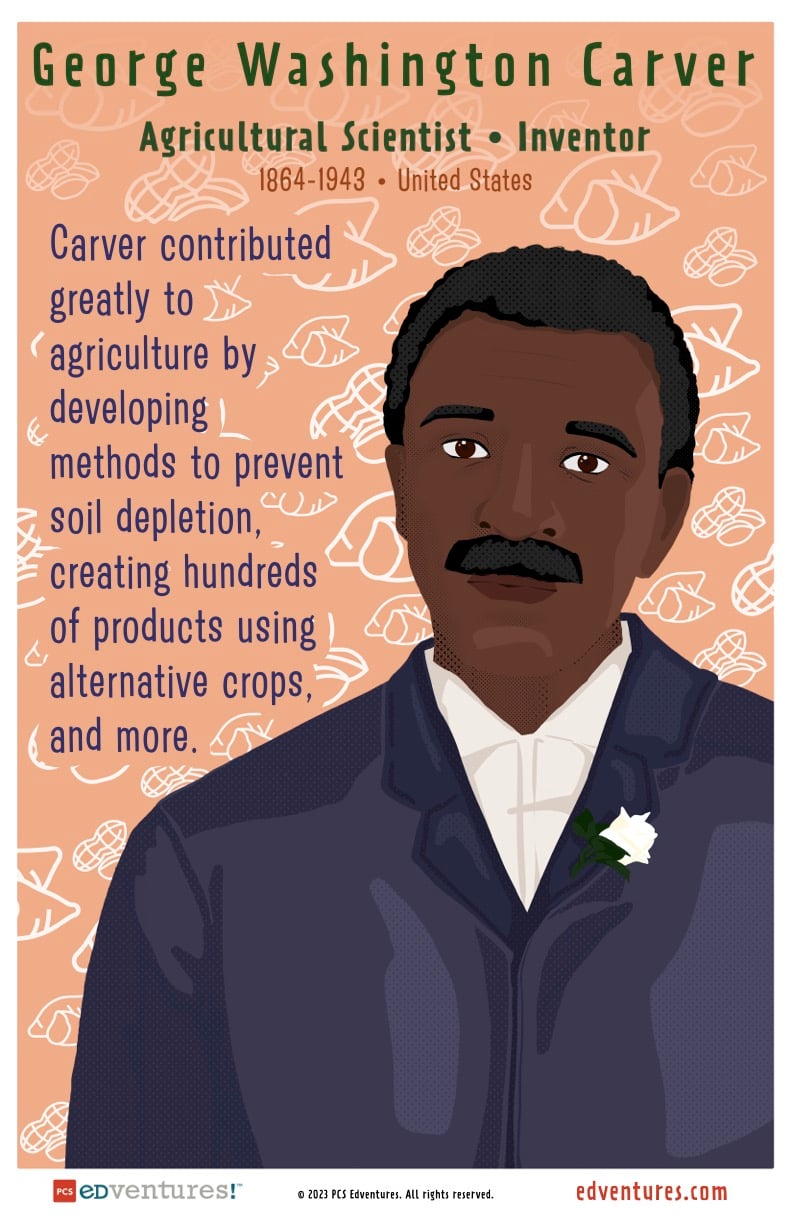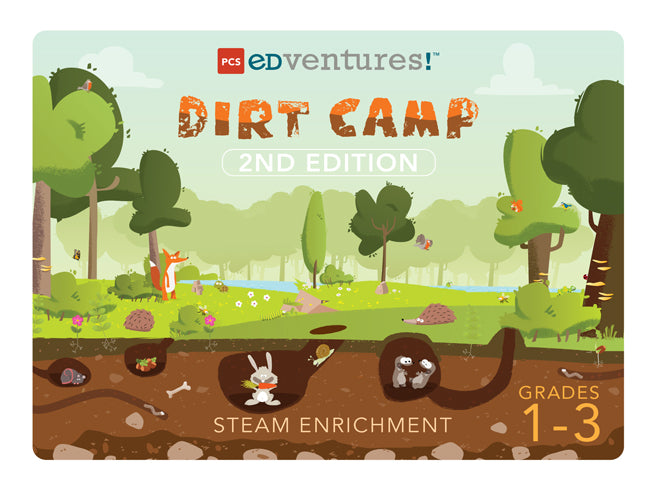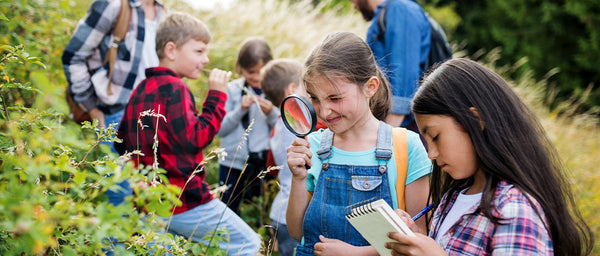
STEAM in History: George Washington Carver
Try this mental workout: How many different ways can you repurpose a sweet potato? Go ahead! Take a moment to list as many as you can.
Remarkably, throughout his lifetime, George Washington Carver developed 118 products from the humble sweet potato, not to mention his 300 peanut creations and other sustainable crop innovations. How resourceful! Thanks to his ingenuity, Carver also brought new life to agriculture in the American South and improved the well-being of many across the country.

Innovation Rooted in Southern Agriculture:
Though he became the first African American to earn a Bachelor of Science degree, George Washington Carver’s story began in the throes of slavery. He was raised by slave owners, Moses and Susan Carver. They became more like foster parents to him and his brother after slave raiders kidnapped the boys’ mother and sister. Though Carver was also kidnapped, Moses and Susan were able to rescue him — an infant at the time — by trading him for one of their best horses. Before moving elsewhere to pursue a better education, Susan taught him to read, write and do work around the house, including gardening. Perhaps that’s where his love for botany began to blossom.
After years of study, Carver landed a job at Tuskegee Institute, working alongside Booker T. Washington. There, he taught classes and worked in his lab throughout his career. As the only African American with a Master of Agriculture degree, he was known for sharing his belief in racial equality throughout the South.
Carver was also passionate about helping poor Southern farmers. Over time, farmers noticed a decline in cotton's vitality after planting their crops in the same fields for years. Carter studied the soil and soon made a groundbreaking discovery. He proposed a crop rotation method, suggesting the cultivation of peanuts, soybeans and sweet potatoes in fields that were traditionally used to grow cotton. These plants replenished nutrients that cotton crops had depleted, leading to higher cotton yields when eventually replanted. In time, the soil was rejuvenated, and the South’s cash crop was revived.

Carver’s discovery is just one of the many exciting things we can learn from studying soil. Check out our Dirt Camp Enrichment Program and dig into a wide range of exciting insights waiting to be unearthed!
The success of Carter’s crop rotation meant more peanuts, soybeans and sweet potatoes were growing than possibly ever before.
In response, Carter developed a seemingly endless list of products derived from these plants. Take a look at just a few of his inventions. Some were merely ideas while others were more widely used:
Peanuts:
- Plastics
- Synthetic Rubber
- Paper
- Milk
- Cheese
- Soap
- Grease
- Worcestershire Sauce
- Wood Stains
- Peanut-Based Medicines
- Insecticides
- Shampoo
- Shaving Cream
- Hand Lotion
Sweet Potato:
- Flour
- Vinegar
- Stains
- Dyes
- Paints
- Writing Ink
Soybeans:
- Process for producing paints and stains
- A lightweight plastic car body
- Other strong plastics and fibers
Some products were intended to help the less fortunate. For instance, Carter used peanut oil to create a massage treatment that he believed helped relieve the pain of those suffering from polio. In addition, much of his work focused on repurposing the crops to address shortages that came with the hardships of World War I. Today, his inventive solutions offer compelling examples of how food waste can be minimized.
STEAM Challenge: Carver-Inspired Sustainable Recipes:
Here’s a unique STEAM design challenge fans of George Washington Carver will go nuts over! Challenge learners to assess the sustainability of an existing recipe and adapt it to reduce food waste.
- Review the Recipe: Read through the recipe’s ingredients and quantities. Identify any potential areas where food waste may occur.
- Analyze Ingredients: Examine the sustainability of the ingredients used in the recipe. Consider whether they're in season, where they came from and if they're sustainable.
- Identify Potential Waste: Determine which steps in the recipe could lead to food waste. For example, will there be unused vegetable peels or leftover portions of ingredients?
- Brainstorm Ways to Reduce Waste: Develop strategies to reduce waste and adapt the recipe for the better! You might try:
- Using leftovers from the recipe in other dishes.
- Finding new ways to repurpose vegetable scraps or other parts of ingredients that are typically thrown away.
- Adjusting portion sizes.
Inspire learners to think outside the box. See how STEAM role model Elif Bilgin used banana peels to create bioplastics.
- Document: Encourage learners to document their creations and share their experiences.
- You can too! SHARE your Carver-inspired recipe revamps with us by tagging us on Twitter @PCSEdventures.
Click for free printable posters and trading cards about George Washington Carver and more STEAM role models to share with your learners!
More STEAM Role Models:
Click the links below to learn about more inspiring, diverse STEAM role models:
- Freebies: STEAM in History Posters & Trading Cards
- Blog: Make Environmental Education a Year-Long Effort
- Blog: STEAM in History: Fionn Ferreira
- Video: Interview - Gardening for STEM Education

Author: Jessica Ventre
An experienced elementary educator and science instructional coach, Jessica’s passion for STEM instruction and student-led learning is always at the forefront of her lessons and professional development workshops.
References:
George Washington Carver. (n.d.). Missouri Dept. of Agriculture. https://agriculture.mo.gov/gwc.php
George Washington Carver. (2022, December 10). SHSMO Historic Missourians. https://historicmissourians.shsmo.org/george-washington-carver/
History.com Editors. (2009, October 27). George Washington Carver. History.com. https://www.history.com/topics/black-history/george-washington-carver
History.com Editors. (2009, November 13). George Washington Carver begins experimental project with Henry Ford. History.com. https://www.history.com/this-day-in-history/george-washington-carver-begins-experimental-project-with-henry-ford
Wright, J. (2014, February 25). More than “the peanut man.” USDA. https://www.usda.gov/media/blog/2014/02/25/more-peanut-man









